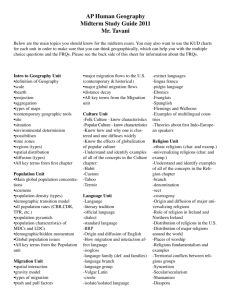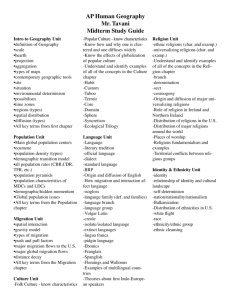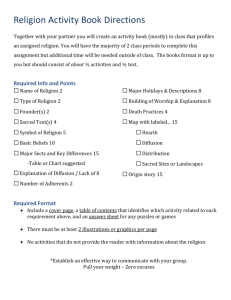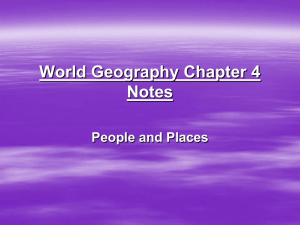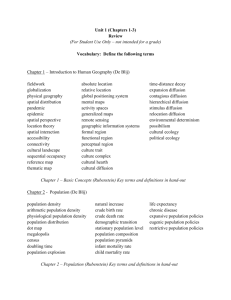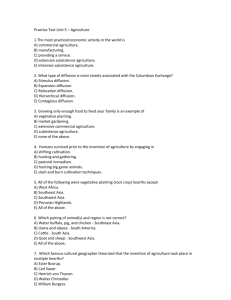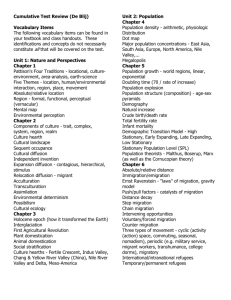End of Course Exam
advertisement
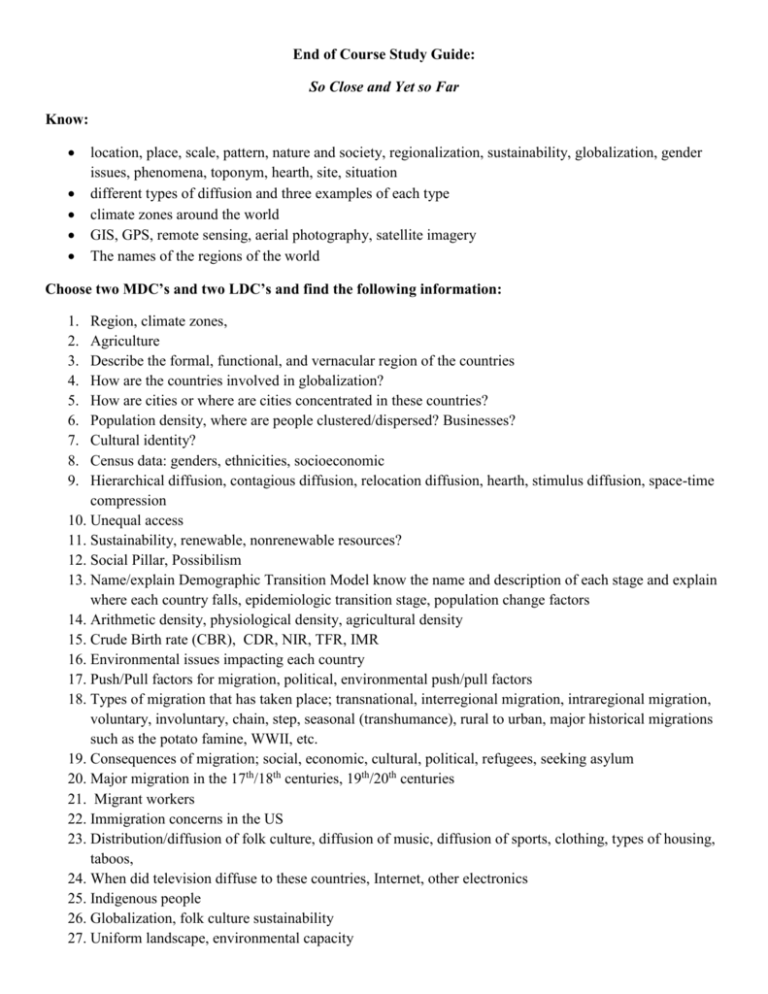
End of Course Study Guide: So Close and Yet so Far Know: location, place, scale, pattern, nature and society, regionalization, sustainability, globalization, gender issues, phenomena, toponym, hearth, site, situation different types of diffusion and three examples of each type climate zones around the world GIS, GPS, remote sensing, aerial photography, satellite imagery The names of the regions of the world Choose two MDC’s and two LDC’s and find the following information: 1. 2. 3. 4. 5. 6. 7. 8. 9. Region, climate zones, Agriculture Describe the formal, functional, and vernacular region of the countries How are the countries involved in globalization? How are cities or where are cities concentrated in these countries? Population density, where are people clustered/dispersed? Businesses? Cultural identity? Census data: genders, ethnicities, socioeconomic Hierarchical diffusion, contagious diffusion, relocation diffusion, hearth, stimulus diffusion, space-time compression 10. Unequal access 11. Sustainability, renewable, nonrenewable resources? 12. Social Pillar, Possibilism 13. Name/explain Demographic Transition Model know the name and description of each stage and explain where each country falls, epidemiologic transition stage, population change factors 14. Arithmetic density, physiological density, agricultural density 15. Crude Birth rate (CBR), CDR, NIR, TFR, IMR 16. Environmental issues impacting each country 17. Push/Pull factors for migration, political, environmental push/pull factors 18. Types of migration that has taken place; transnational, interregional migration, intraregional migration, voluntary, involuntary, chain, step, seasonal (transhumance), rural to urban, major historical migrations such as the potato famine, WWII, etc. 19. Consequences of migration; social, economic, cultural, political, refugees, seeking asylum 20. Major migration in the 17th/18th centuries, 19th/20th centuries 21. Migrant workers 22. Immigration concerns in the US 23. Distribution/diffusion of folk culture, diffusion of music, diffusion of sports, clothing, types of housing, taboos, 24. When did television diffuse to these countries, Internet, other electronics 25. Indigenous people 26. Globalization, folk culture sustainability 27. Uniform landscape, environmental capacity 28. Recycling, other environmental solutions 29. Languages families, branch, group 30. Diffusion of languages, nomadic warrior hypothesis, sedentary farmer hypothesis, dialects, 31. Distinguish between and language and a dialect, preserving languages, diversity, lingua franca, diffusion to other languages 32. Religion distribution, branches, universalizing religions, monotheism, polytheism, animism 33. Know the world’s major religions, Christianity, Muslim, Judaism, Hinduism, 34. How religions diffused, sacred sites 35. Landscape of ethic religions, burying the dead, hierarchical religions, autonomous religions, religious conflicts past and today 36. Know about the West bank 37. Ethnicities, where clustered, dispersed, urban, regional, forced migration (slavery), White Flight,, Aparthied, ethnic conflicts, think Sudan, Rwanda, 38. Centripetal force, nationalism, dividing ethnicities 39. Ethnic cleansing, balkenization 40. Symbolic landscapes, differences in cultural attitudes and practices towards the environment 41. The United nations 42. Defining states, how set up, dispersed, distributed, claims to the polar regions, nation-states, largest multi-national state, colonialism 43. Types of boundaries, physical, cultural, political, ethnic 44. Elongated states, enclaves, exclaves, fragmented, landlocked, perforated, prorupted states 45. Forms of government; democratization, imperialism, colonialism, federal states, unitary states, gerrymandering 46. Fall of Communism and the legacy of the Cold War 47. European Union 48. Terrorism, Isis, Taliban, AlQuida 49. Primary, secondary, tertiary sectors 50. Human Development Index, GNP, GDP, GNI, value added, inequality-adjusted HDI 51. Access to healthcare, sanitation, education especially women and girls 52. Life expectancy, education 53. Gender inequality 54. Women’s rights, roles, access to education, working, labor force, 55. Energy supply and demand, reserves, fracking, OPEC, Nuclear energy, renewable energy, solar energy 56. Developmental paths; self-sufficient, international trade, WTO 57. Rostow Model, Self-sufficiency Model 58. Housing bubble 59. Fair trade, microfinance 60. Milinuem developmental goals 61. Core and Periphery Model 62. Green Revolution 63. Neolithic agricultural revolution, second agricultural revolution 64. Major agricultural regions 65. Crop Hearths, animal hearths 66. Rural land use, types of crops grown, interdependence among regions of food production and consumption 67. Land use/coverage, irrigation, conservation to restore natural land cover 68. Pastoralism, Von Thunen’s Theory 69. Undernourishment, undernutrition, hunger vulnerability, food security/insecurity, among women/children 70. Roles of women in agriculture 71. Six agricultural regions in developed countries (page 357) 72. Pastoral nomadism 73. Shifting cultivation, intensive subsistence farming, double cropping, truck farming, dairy farming, drug farming 74. Mediterranean farming 75. Commercial farming 76. Africa’s food struggles 77. Subsistence farming in developed countries 78. GMO’s 79. Environmental issues, strategies to increase food supply 80. Sustainable agriculture 81. Government developed initiatives local, regional, globally 82. Rise of technology industries 83. Know industrial regions of the world (pg. 396-7) 84. Situation and site factors (industries) single market manufacturers 85. Pollution from industries 86. Right to work laws 87. Gender equity in the workplace 88. BRIC 89. Outsourcing, just-in-time delivery 90. GDP, HDI, GII 91. Wallerstein’s World Systems Theory 92. Types of services (pg. 431-2) 93. Market area hinterland 94. Central Place Theory 95. Use of hexagons for market areas 96. Threshold 97. Rank-size rule, primate city rule 98. Gravity model 99. Climate change 100. Global cities, three levels (pg. 442 101. Hierarchy of business services 102. Off shore financial services 103. Clustered rural settlements 104. Urbanization and forces driving urbanization 105. Borcher’s epochs of urban transportation development 106. Burgess concentric zone 107. Hoyt sector model 108. Harris and Ullman multiple nuclei model 109. Galactic city model 110. 111. 112. 113. 114. 115. 116. 117. 118. 119. 120. 121. 122. 123. 124. 125. 126. 127. 128. 129. 130. 131. 132. 133. 134. 135. Gentrification Social heterogeneity Central Business District (CBD) Businesses clustered downtown? Push pull factors why not many people live in cities Food desert Underground CBD, skyscrapers Market segmentation Concentric zones in cities of developing countries Sectors in cities of developing countries Peripheral Model Density gradient Suburban sprawl Segregation Suburbanization of business, consumer, Public Transit Cars of the future Gentrification, deterioration (490) Underclass, suburban stress Recession, urban tax break. Zones of abandonment, Urban environmental issues Changing demographic employment and social structure, Housing and insurance discrimination, debt crises Disamenity Edge cities - Uptowns(High income), boombergs (rapidly created suburbs), greenfields
